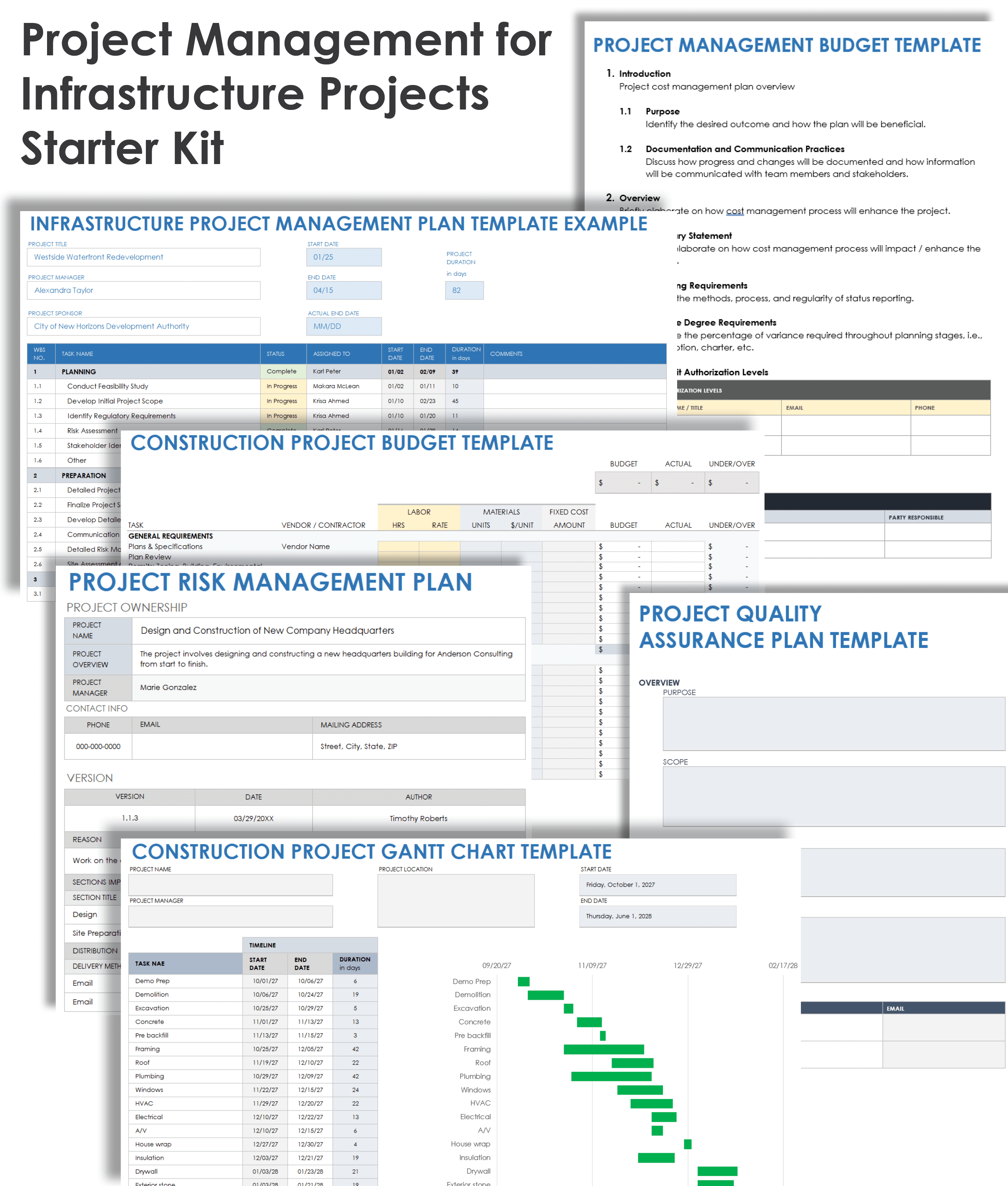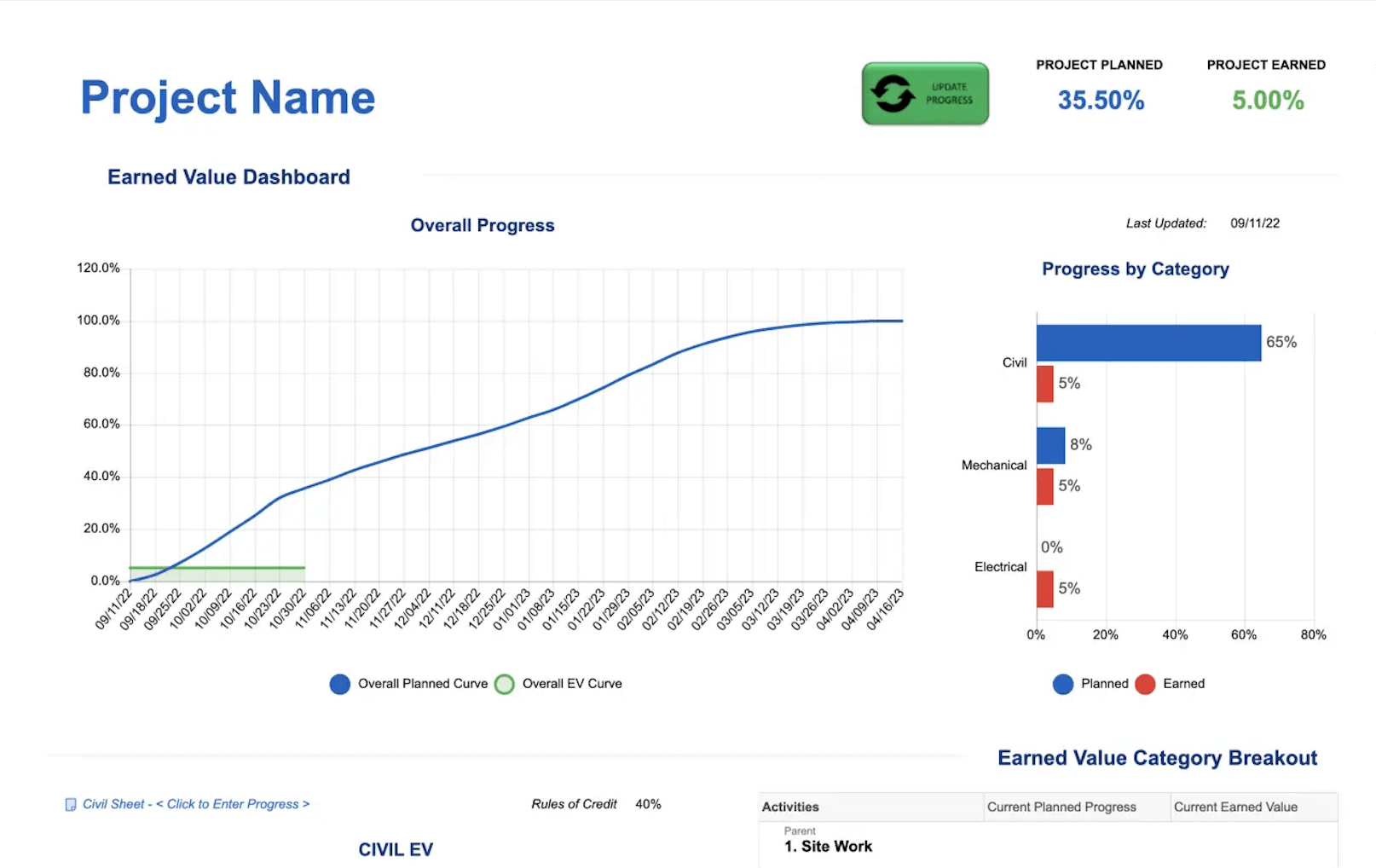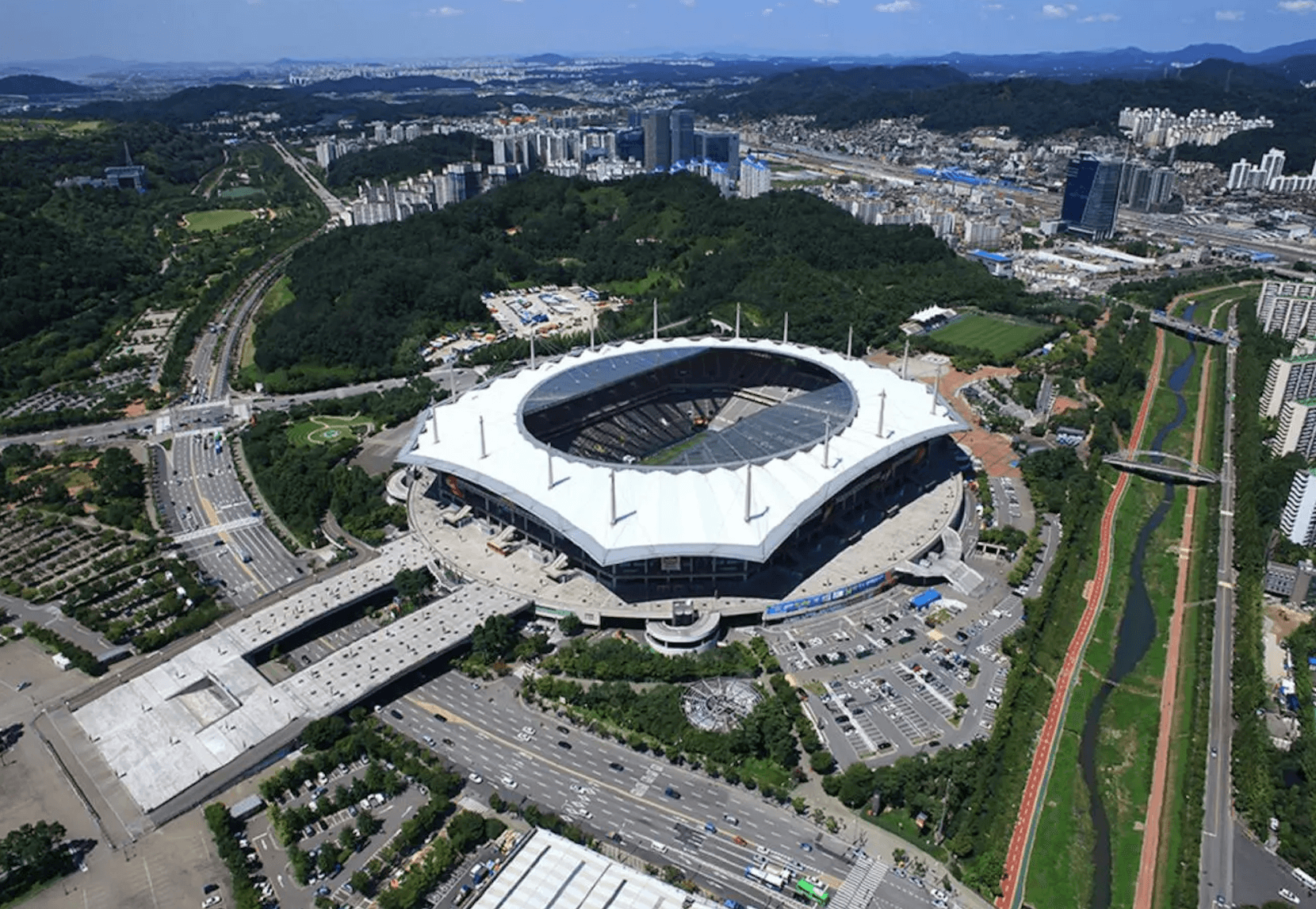What Is Infrastructure Project Management?
Infrastructure project management involves overseeing and directing large-scale projects that focus on the construction, renovation, or maintenance of infrastructure. Project managers specializing in infrastructure projects often focus on specific project types, including technology, environmental, utility, or transportation.

“Managing infrastructure projects requires a nuanced understanding distinct from regular project management,” says Garth McAlpin, Director and National Fulfillment Manager at Classic Architectural Group. “The divergence lies in the type of infrastructure — be it technology, business, or economic. For instance, technology infrastructure projects may align with the software development lifecycle (SDLC) and employ Agile methodologies, which are less likely in economic or business infrastructure endeavors.”
Infrastructure Project Management Lifecycle
Infrastructure project management requires a holistic approach that considers the entire lifespan of the infrastructure, not just the initial construction phase. The lifecycle typically includes stages such as planning, design, procurement, construction, operation, maintenance, and eventual decommissioning or renewal.
This lifecycle is distinct from other projects primarily in its complexity and long-term nature, as well as the significant ongoing maintenance and operational requirements after the initial construction. Infrastructure projects also often involve larger teams, more stakeholders, greater regulatory scrutiny, and a stronger focus on long-term sustainability and community impact.
Six Phases of Infrastructure Project Management
The infrastructure project lifecycle typically encompasses several key phases, from initial conception to closure to decommissioning or renewal. Here’s a general overview of each stage:
- Planning: This stage involves setting the project’s objectives, conducting feasibility studies, defining the project scope, designing the project, and assessing environmental impacts.
- Preparation: This phase focuses on getting regulatory approvals, acquiring necessary land, engaging with stakeholders, and developing a comprehensive risk management plan.
- Procurement: At this stage, the project involves tendering processes, selecting contractors, allocating resources, and executing contracts.
- Implementation: This is the phase where the actual managing of the construction takes place, along with ensuring quality assurance, monitoring performance, and commissioning the project.
- Closure: This phase involves formally handing over the project, conducting post-implementation reviews, preparing closure documentation, and conducting satisfaction surveys.
- Decommissioning/Renewal: This final stage includes disposing of or repurposing assets, rehabilitating the site, upgrading technology, and redesigning the infrastructure for new uses.
There are many ways to break down the infrastructure project lifecycle. The important thing is to break down the project into clear sections to show progress. For example, the authors of this paper on the execution of the infrastructure project lifecycle, from Manado State Polytechnic, break down the project lifecycle into only four phases: planning, selection of service providers, construction processes, and construction product handover.
Similarly, the U.S. Department of Transportation (DOT) recommends dividing projects into these four steps: plan, fund, deliver, and maintain.
Infrastructure Project Management Starter Kit
Infrastructure projects are known for their complexity and large scale. This free, downloadable starter kit has the basic elements any project manager needs to get started on their next big infrastructure project.

Download the Infrastructure Project Management Starter Kit
In this kit, you’ll find the following:
- A blank infrastructure project management plan template for Excel to help you outline your approach to a complex project through project closure.
- A sample infrastructure project management plan template for Excel for additional guidance.
- A project risk management plan template for Excel to help you manage complex environmental, financial, and other risks.
- A construction project budget template for Excel to help you allocate financial resources for the construction portion of an infrastructure project.
- A project management budget template for Microsoft Word to help you manage all budgetary aspects of your project.
- A
construction project Gantt chart template
for Excel to help you keep track of project tasks throughout the project lifecycle.
A project quality assurance plan template for Microsoft Word to help you ensure that all aspects of the infrastructure project are held to the highest possible standard.
Infrastructure Projects Categories
Infrastructure project management covers a broad range of projects, such as transportation, technology, utility, social, environmental, and industrial. These categories reflect the diverse nature of infrastructure projects, each with its unique challenges and requirements.
Here are some major categories of infrastructure projects:
Transportation Infrastructure
Transportation infrastructure plays a crucial role in the functioning of modern societies and economies. Managing these projects requires a multidisciplinary approach, incorporating elements of civil engineering, financial management, law, public policy, and environmental science.
Here are some basic types of transportation infrastructure projects:
- Roads and Highways: Construction and maintenance of roads, highways, bridges, and tunnels.
- Railways: Development of railway networks, including tracks, stations, and signaling systems.
- Airports: Construction and expansion of airport facilities, runways, and associated infrastructure.
- Ports and Harbors: Development and improvement of sea and river ports, including docks, quays, and cargo handling areas.
- Public Transit Systems: Development of urban transit networks, including buses, trams, and metro systems.
Case Study: The Federal Railroad Administration (FRA), a subset of the U.S. Department of Transportation, provides a draft statement of work framework on its website. This document is a real-world example that outlines the specific tasks involved in planning and developing intercity passenger rail services. It considers all the crucial elements of a transportation infrastructure project, from project management, alternatives analysis, and transportation planning to environmental planning, financial planning, and phased implementation.
Utility Infrastructure
Utility infrastructure is crucial because it provides essential services, such as electricity, water, natural gas, and telecommunications to homes, businesses, and public facilities.
Here are some basic types of utility infrastructure projects:
- Energy Generation and Distribution: Power plants (coal, gas, nuclear, renewable energy), electrical grids, and distribution networks.
- Telecommunications: Networks for telephone, internet, and broadcast communication, including towers, cables, and data centers.
- Water Supply and Sanitation: Systems for water purification, distribution, sewage treatment, and sanitation facilities.
Case Study: Williams — an energy company based in Tulsa, Oklahoma — is one of the largest providers of natural gas infrastructure in North America. For its large-scale construction projects, the company needs to keep up with state-of-the-art project management strategies and tools. Check out this quantity-based earned value template that the company uses to track physical quantities of milestones accomplished on site, providing a more accurate view of project progress.

Social Infrastructure
Social infrastructure includes schools, hospitals, parks, and cultural institutions that impact daily life and well-being. It supports social services and community engagement. Managers of social infrastructure projects have to juggle diverse stakeholder requirements, cultural considerations, and shifting public needs.
Here are some basic types of social infrastructure projects:
- Educational Facilities: Schools, universities, and research institutions.
- Healthcare Facilities: Hospitals, clinics, and other healthcare structures.
- Public Buildings: Government buildings, courthouses, libraries, and cultural establishments, such as museums and theaters.
Case Study: Hanmi Global, Korea’s leading construction and project management company, oversees many massive social infrastructure projects that require complex data compilation. The company centralized its systems and streamlined the workflow, which was key to producing the real-time data visualization necessary for construction projects such as the Seoul World Cup Stadium:

If you want to learn more about managing construction projects — from building family homes to running big projects like this one — check out this informative introductory guide to construction project management.
Environmental Infrastructure
Environmental infrastructures play a vital role in preserving natural ecosystems, ensuring public health and safety, and supporting sustainable development.
Here are some examples of environmental infrastructure:
- Parks and Green Spaces: Development and maintenance of public parks, gardens, and conservation areas.
- Waste Management: Facilities for waste collection, recycling, and disposal, including landfills and waste-to-energy plants.
- Water Resources Management: Dams, reservoirs, flood control systems, and irrigation systems.
Case Study: The Gowanus Canal dredging project is a major environmental remediation effort aimed at cleaning up one of the most polluted waterways in the United States, the Gowanus Canal in Brooklyn, New York. Initiated as part of a Superfund cleanup, the project involves removing contaminated sediment, capping dredged areas to prevent further pollution, improving water quality, and restoring the canal’s ecosystem.
Projects like this that have an outsized impact on the environment, public health, and urban development require robust stakeholder engagement. This community involvement plan was developed by the U.S. Environmental Protection Agency (EPA) to facilitate two-way communication between the agency and the community surrounding the site. Notice how the document outlines a comprehensive action plan for community engagement through meetings, information dissemination, and the use of social media.
Industrial Infrastructure
Industrial infrastructure projects must consider more stringent environmental and safety regulations due to the potential hazards associated with industrial activities. They also often require the integration of specialized equipment and technologies.
Here are some examples of industrial infrastructure:
- Manufacturing Facilities: Factories and industrial plants for various industries.
- Warehousing and Logistics: Storage facilities and distribution centers.
- Mining Infrastructure: Facilities related to the extraction and processing of minerals and other natural resources.
Case Study: The Sonora Lithium Project, located in northwest Mexico, entails the development of an open-pit mine and lithium carbonate processing facility, with a lifespan of more than 20 years. This pre-feasibility study from 2016 is a great example of the extensive planning that goes into preparing for an industrial infrastructure project. The report covers diverse aspects in detail, such as the geological setting, site history, environmental liabilities, permit requirements, and much more.
Technology Infrastructure
Also called IT infrastructure, technology infrastructure provides the backbone for digital operations and communication in modern society. It supports data storage, processing, and transmission.
Here are some examples of technology infrastructure:
- Cloud Computing Platforms: Virtualized resources for computing, storage, and networking, all accessible over the internet.
- Cybersecurity Systems: Infrastructure for protecting IT assets, including firewalls, intrusion detection systems, and encryption technologies.
- Data Centers: Facilities that house servers, storage systems, and networking hardware for data processing and storage.
- Network Infrastructure: Routers, switches, firewalls, and cabling systems for internal and external communication.
Case Study: Project Natick was an innovative experiment by Microsoft to deploy a self-sufficient underwater data center. The project aimed to explore the feasibility of subsea data centers for sustainable and energy-efficient operations. In this case, project manager Ben Cutler had to work closely with highly specialized engineers, researchers, and technical staff to make the project a success.
In this case study, Cutler’s team was attempting something that had never been done before, so they employed smaller-scale feasibility tests to avoid wasting resources. “Literally, the first thing we did was take a small set of servers — 24 — basically put them in the can, and then sink them in the Pacific Ocean,” Microsoft’s Cutler explained in a podcast interview.
“It was about 11 meters of water and it was right next to our research pier, so it was easy access. It was really a proof of concept. Does this work? Can we cool it effectively? Can we survive in the ocean? And on the strength of that, we proceeded to a phase two,” he continued.
To learn more about managing complex technology projects like this one, see this guide to IT infrastructure project management. Once you’ve submitted all your deliverables, maintain IT systems with this guide to IT infrastructure management.
Finally, for smaller-scale technology projects, find everything you need in this article on IT project management.
Infrastructure Project Management Best Practices
Managing infrastructure projects, with their large scope and investment, requires careful planning, stakeholder engagement, and environmental consideration. When managing these projects, it is important to stay on top of the budget and adopt an Agile approach.
Here are some best practices to keep in mind when managing infrastructure projects:
- Budget Management: Effective budget management involves accurate cost estimates, regular financial monitoring, and contingency planning.
- Communication Strategy: A structured communication plan helps project team members and stakeholders stay informed and make collaborative decisions.
- Comprehensive Planning: Before breaking ground, it is crucial to have a detailed plan in place. Such a plan includes defining the project’s scope, resource requirements, and potential risks.
- Environmental Consideration: Infrastructure projects can significantly impact the environment. Conduct thorough environmental assessments and implement sustainable methods and technologies wherever possible.
- Expert Consulting: Infrastructure projects are highly specialized and require input from experts. “Specialization is key,” says McAlpin. “A background in technology infrastructure might not readily translate into economic infrastructure project management.”
- Quality Assurance: Adopt quality control processes for materials, workmanship, and compliance with relevant standards and regulations to maintain high standards of quality throughout the project lifecycle.
- Risk Management: Identifying, assessing, and managing risks proactively is key to the success of infrastructure projects. In order to perform effective risk management, you must regularly review processes (including the project’s progress and external factors) to ensure the currency of your strategies. “We apply these practices by conducting thorough risk assessments and devising contingency plans, ensuring project resilience,” says McAlpin.
- Stakeholder Engagement: Engage with all stakeholders, from government bodies to the local communities affected by the project.
For more information, see the Organization for Economic Co-operation and Development (OECD) Council’s Recommendation on Governance of Infrastructure, adopted in 2020. This document provides a framework that can help project managers make informed decisions and manage projects more effectively. It emphasizes key focus areas, such as developing a long-term strategic vision and ensuring the following: fiscal sustainability, effective procurement, stakeholder participation, cross-level government coordination, and a coherent regulatory framework.
How to Pick Infrastructure Project Management Software
When selecting infrastructure project management software, consider the ability to handle complex workflows and integrate various aspects, such as scheduling, budgeting, resource allocation, and communication. Evaluate the software’s scalability, user-friendliness, and compatibility with existing systems.
When selecting project management software for an infrastructure project, a project manager should consider several factors:
- Project Complexity: Choose software that can handle the project’s scale and complexity. Teams at Simpson Strong-Tie use software that allows them to automate processes and hide complex data, so they can deliver clear, actionable project plans and reduce duplicate work on their most complex projects.
- User-Friendliness: Software should be intuitive and easy for all team members to use. “We focused on user-friendly platforms, facilitating collaboration and real-time updates,” says McAlpin.
- Collaboration Features: Look for tools that facilitate effective communication and collaboration.
- Integration Capabilities: Ensure that it can integrate with existing systems and tools.
- Budget and Cost: Make sure that it aligns with the project's budget constraints.
- Reporting and Analytics: The software should provide robust reporting and data analysis tools.
- Customization and Flexibility: Choose software that can be tailored to specific project needs. Hanley Energy, an Ireland-based company specializing in critical power management solutions worldwide, needed software that both provided real-time visibility to internal teams and customers and streamlined project processes, from product design to delivery. Implementing new, customizable software resulted in a 33 percent increase in project management efficiency.
- Security and Data Protection: Ensure it has strong security measures.
Specialization in environmental, social, or transportation projects might impact your choice of software. For example, environmental projects might require software with strong compliance tracking features, while transportation projects might benefit from tools with robust scheduling and logistics capabilities. Social infrastructure projects might need software that facilitates community engagement and stakeholder management.
Super-Charge Your Infrastructure Project Management with Planning, Phases, and Software Insights from Smartsheet
From simple task management and project planning to complex resource and portfolio management, Smartsheet helps you improve collaboration and increase work velocity -- empowering you to get more done.
The Smartsheet platform makes it easy to plan, capture, manage, and report on work from anywhere, helping your team be more effective and get more done. Report on key metrics and get real-time visibility into work as it happens with roll-up reports, dashboards, and automated workflows built to keep your team connected and informed.
When teams have clarity into the work getting done, there’s no telling how much more they can accomplish in the same amount of time. Try Smartsheet for free, today.